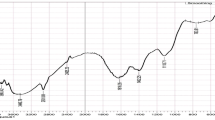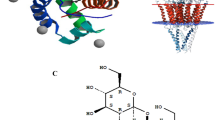Abstract
Upon screening for novel and potential biocompounds with larvicidal activities, we successfully isolated hamisonine (HMSN) a limonoid compound from endophytic fungi Penicillium oxalicum LA-1 of Limonia acidissima. The extracted compound structure was elucidated by spectral studies such as UV-vis spectroscopy, thin-layer chromatography, FTIR, LC-ESI-MS, 1H NMR, and 13C NMR upon comparing with the spectral data available in the literature. Further, the isolated HMSN was tested against III and IV instar Culex quinquefasciatus larvae. The outcome of this study clearly emphasize that the extracted compound HMSN possesses a stupendous larvicidal activity in a dose-dependent manner with the LC50 and LC90 values of 1.779 and 7.685 ppm against III instar larvae and 3.031 and 28.498 ppm against IV instar larvae of C. quinquefasciatus, respectively. Interestingly, the histological studies evidently showing the damage of peritrophic membrane and epithelial cells of testing mosquito larvae.










Similar content being viewed by others
References
Abutaha N, Mashaly AMA, Al-Mekhalfi FA, Muhammed F, Al-shami1 M,WadaanMA (2015) The larvicidal activity of endophytic fungal extract of Cochliobolus specifer on Aedes caspius and Culex pipiens (Diptera: Culicidae). Appl. Entomol. Zool 50:405–414
Ahmad J, Wizarat K, Shamsuddin KM, Zaman A, Connolly JD (1984) Jangomolide, a novel limonoid from Flacourtia jangomas. Phytochemistry 23(6):1269–1270
Al-Mehmadi RM, Al-Khalaf AA (2010) Larvicidal and histological effects of Melia azedarach extract on Culex quinquefasciatus Say larvae (Diptera: Culicidae). J King Saud Univ 22:77–85
Andrew P, BreksaIII DK, Rosalind Y (2008) Wong isolation and identification of the first C-17 limonin epimer, epilimonin. J Agric Food Chem 56(14):5595–5598
Asai T, Otsuki S, Sakurai H, Yamashita K, Ozeki T, Oshima Y (2013) Benzophenones from an endophytic fungus, Graphiopsis chlorocephala, from Paeonia lactiflora cultivated in the presence of an NAD+-dependent HDAC inhibitor. Org Lett 15(8):2058–2061
Attri BS, Prasad GR (1980) Neem oil extractives—an effective mosquito larvicide. Indian J. Entomol 42:371–374
Banerjee S, Singha S, Laskar S, Chandra G (2011) Efficacy of Limonia acidissima L.(Rutaceae) leaf extract on larval immatures of Culex quinquefasciatus Say 1823. Asian Pac. J Trop Med 4(9):711–716
Barbara C, Michele L, Luisa P, Raffaele P, Ines O, Giovanni B (2013) Larvicidal and repellent activity of essential oils from wild and cultivated Ruta chalepensis L. (Rutaceae) against Aedes albopictus Skuse (Diptera: Culicidae), an arbovirus vector. Parasitol Res 112(3):991–999
Bayazit V, Konar V (2010) Biochemical and physiological evaluations of limonoids as potential cancer destroyers. J of Animal and Veterinary Advances 9(7):1099–1107
Bernhard L, Bernhard P, Magnusson P (2003) Management of patients with lymphedema caused by filariasis in north eastern Tanzania: alternative approaches. Physiol 89:743–749
Chavan SR (1984) Chemistry of alkanes separated from leaves of Azadirachta indica and their larvicidal/insecticidal activity against mosquitoes. In: Schmutterer, H., Ascher, K.R.S. (Eds.), Natural pesticides from the neem tree and other tropical plants. Schriftenreihe der GTZ., No. 161. Eschborn, Germany, pp. 91–94
Chavan SR, Deshmukh PB, Renapurkar DM (1979) Investigations of indigenous plants for larvicidal activity. Bull Haffkine Inst 7:23–33
Chen G, Zhu Y, Wang HZ, Wang SJ, Zhang RQ (2007) The metabolites of a mangrove endophytic fungus, Penicillium thomi. J Asian Nat Prod Res 9(2):159–164
Elimat TE, Raja HA, Graf TN, Faeth SH, Cech NB, Oberlies NH (2014) Flavonolignans from Aspergillus iizukae, a fungal endophyte of milk thistle (Silybum marianum). J Nat Prod 77(2):193–199
Elumalai D, Hemavathi M, Hemalatha P, Deepaa CV, Kaleena PK (2016) Larvicidal activity of catechin isolated from Leucas aspera against Aedes aegypti, Anopheles stephensi and Culexquinquefasciatus (Diptera: Culicidae). Parasitol Res 115:1203–1212
Hamouda LS, Elayassaki WM, Hamed MS (1996) Toxicity and histopathological effect of Artmisia judaic and Anagallis arvensis extracts on Culex pipiens larvae. J Egypt Ger Soc Zool 20:43–60
Hancock PA, Sinkins SP, Godfray HCJ (2011) Strategies for introducing Wolbachia to reduce transmission of mosquito-borne diseases. PLOS Neglected Tropical Disease 5:e1024
Hardoim PR, van Overbeek LS, Berg G, Pirttilä AM, Compant S, Campisano A, Döring M, Sessitsch A (2015) The hidden world within plants: ecological and evolutionary considerations for defining functioning of microbial endophytes. Microbiol Mol Biol Rev 79(3):293–320
Hooper PJ, Bradley MH, Biswas G, Ottesen EA (2009) The global programme to eliminate lymphatic filariasis: health impact during its first 8 years (2000–2007). Annals of Tropical Medicine & Parasitology 103:17–21
Joseph CC, Ndoile MM, Malima RC, Nkunya MHH (2004) Larvicidal and mosquitocidal extracts, a coumarin, isoflavonoids and pterocarpans from Neorautanenia mitis. Trans Royal Soc Trop Med Hyg 98:451–455
Koolen HH, Soares ER, Silva FM, Almeida RA, Souza AD, Medeiros LS, Rodrigues Filho E, Souza AQ (2012) An antimicrobial alkaloid and other metabolites produced by Penicillium sp. An endophytic fungus isolated from Mauritia flexuosa L. f. Química Nova 35(4):771–774
Kweka EJ, Zhou G, Munga S, Lee MC, Atieli HE, Nyindo M, Githeko AK, Yan G (2012) Anopheline larval habitats seasonality and species distribution: a prerequisite for effective targeted larval habitats control programmes. PLoS One 7:e52084
Li XJ, Zhang Q, Zhang AL, Gao JM (2012) Metabolites from Aspergillus fumigatus, an endophytic fungus associated with Melia azedarach, and their antifungal, antifeedant, and toxic activities. J Agric Food Chem 60(13):3424–3431
Liu JF, Chen WJ, Xin BR, Lu J (2014) Metabolites of the endophytic fungus Penicillium sp. FJ-1 of Acanthus ilicifolius. Nat Prod Commun 9(6):799–801
Li JW, Duan RG, Zou JH, Chen RD, Chen XG, Dai JG (2014) Meroterpenoids and isoberkedienolactone from endophytic fungus Penicillium sp. associated with Dysosma versipellis. Yao xue xue bao=Acta pharmaceutica Sinica 49(6):913–920
Li H, Qing C, Zhang Y, Zhao Z (2005) Screening for endophytic fungi with antitumour and antifungal activities from Chinese medicinal plants. World J Microbiol Biotechnol 21:1515–1519
Liu C, Liu J, Rong Y, Liang N, Rong L (2012) Aqueous extraction of limonin from Citrus reticulate Blanco. Czech J Food Sci 30(4):364–368
MacLeod JK, Moeller PD, Bandara BR, Leslie Gunatilaka AA, Wijeratne EK (1989) Acidissimin, a new limonoid from Limonia acidissima. J Nat Prod 52(4):882–885
Murray NEA, Quam MB, Smith AW (2013) Epidemiology of dengue: past, present and future prospects. Clin Epidemiol 5:299–309
Muthu C, Reegan AD, Kingsley S, Ignacimuthu S (2012) Larvicidal activity of pectolinaringenin from Clerodendrum phlomidis L. against Culex quinquefasciatus Say and Aedes aegypti L. (Diptera: Culicidae). Parasitol Res 111(3):1059–1065
Netala VR, Kotakadi VS, Gaddam SA, Ghosh SB, Tartte V (2016) Elicitation of gymnemic acid production in cell suspension cultures of Gymnema sylvestre R.Br. through endophytic fungi. Biotech 6(2):232
Parthasarathy R, Sathiyabama M (2014) Gymnemagenin-producing endophytic fungus isolated from a medicinal plant Gymnema sylvestre R.Br. Appl Biochem Biotechnol 172:3141–3152
Peterson SW, Vega FE, Posada F, Nagai C (2005) Penicillium coffeae, a new endophytic species isolated from a coffee plant and its phylogenetic relationship to P. fellutanum, P. thiersii and P. brocae based on parsimony analysis of multilocus DNA sequences. Mycologia 97(3):659–666
Porras-Alfaro A, Bayman P (2011) Hidden fungi, emergent properties: endophytes and microbiomes. Annu Rev Phytopathol 49:291–315
Prabukumar S, Rajkuberan C, Ravindran K, Sivaramakrishnan S (2015) Isolation and characterization of endophytic fungi from medicinal plant Crescentia cujete L. and their antibacterial, antioxidant and anticancer properties. Int J Pharm Pharm Sci 7:316–321
Prabukumar S, Sathishkumar G, Rajkuberan C, Gobinath C, Murugan K, Sivaramakrishnan S (2017) Isolation and characterization of anticancer flavone chrysin (5,7-dihydroxy flavone)-producing endophytic fungi from Passiflora incarnata L. leaves. Ann Microbiol 67:321
Pudhom K, Teerawatananond T (2014) Rhytidenones A-F, Spirobisnaphthalenes from Rhytidhysteron sp. AS21B, an endophytic fungus. J Nat Prod 77(8):1962–1966
Qiu M, Xie R, Shi Y, Chen H, Wen Y, Gao YS, Hu X (2010a) Isolation and identification of endophytic fungus SX01, a red pigment producer from Ginkgo biloba L. World J Microbiol Biotechnol 26:993–998
Qiu M, Xie RS, Shi Y, Zhang HH, Chen HM (2010b) Isolation and identification of two flavonoid-producing endophytic fungi from Ginkgo biloba L. Ann Microbiol 60:143–150
Reegan AD, Gandhi MR, Paulraj MG, Balakrishna K, Ignacimuthu S (2014) Effect of nilocitin, a protolimonoid isolated from Limonia acidissima L. (Diptera: Culicidae). Acta Trop 139:67–76
Roy A, Saraf S (2006) Limonoids: overview of significant bioactive triterpenes distributed in plants kingdom. Biol Pharm Bull 29(2):191–201
Mazid S, Kalita JC, Rajkhowa RC (2011) A review on the use of biopesticides in insect pest management. International Journal of Science and Advanced Technology 1:169–178
Schulz B, Boyle C, Draeger S, Rommert AK (2002) Endophytic fungi: a source of novel biologically active secondary metabolites. Mycol Res 106:996–1004
Senthilkumar N, Varma P, Gurusubramanian G (2009) Larvicidal and adulticidal activities of some medicinal plants against the malarial vector, Anopheles stephensi (Liston). Parasitol Res 104:237–244
Senthil-Nathan S (2013) Physiological and biochemical effect of neem and otherMeliaceae plants secondary metabolites against Lepidopteran insects. Front Physiol 4:1–17
Shweta S, Zuehlke S, Ramesha BT, Priti V, Mohana Kumar P, Ravikanth G, Spiteller M, Vasudeva R, Shaanker UR (2010) Endophytic fungal strains of Fusarium solani, from Apodytes dimidiata E. Mey. ex Arn (Icacinaceae) produce camptothecin, 10-hydroxycamptothecin and 9-methoxycamptothecin. Phytochemistry 71:117–122
Siriwardane AM, Kumar NS, Jayasinghe L, Fujimoto Y (2015) Chemical investigation of metabolites produced by an endophytic Aspergillus sp. isolated from Limonia acidissima. Nat Prod Res 29(14):1384–1387
Singh D, Rathod V, Ninganagouda S, Hiremath J, Singh AK, Mathew J (2014) Optimization and characterization of silver nanoparticle by endophytic fungi Penicillium sp. isolated from Curcuma longa (turmeric) and application studies against MDR E. coli and S. aureus. Bioinorg Chem Appl 2014:1–8
Sunish IP, Rajendran R, Mani TR, Munirathinam A, Dash AP, Tyagia BK (2007) Vector control complements mass drug administration against bancroftian filariasis in Tirukoilur, India. Bull World Health Organ 85(2):138–145
World Health Organization. (2014) A global brief on vector-borne diseases
Yu H, Zhang L, Li L, Zheng C, Guo L, Li W, Sun P, Qin L (2010) Recent developments and future prospects of antimicrobial metabolites produced by endophytes. Microbiol Res 165:437–449
Zhang P, Lia XM, Liu H, Lia X, Wang BG (2015) Two new alkaloids from Penicillium oxalicum EN-201, an endophytic fungus derived from the marine mangrove plant Rhizophora stylosa. Phytochem Lett 13:160–164
Zhao J, Zhou L, Wang J, Shan T, Zhong L, Liu X, Gao X (2010) Endophytic fungi for producing bioactive compounds originally from their host plants. Curr Res Technol Educ Trop Appl Microbiol Microb Biotechnol:567–576
Acknowledgement
The authors are thankful to University grants commission-Special Assistance Programme (UGCSAP), New Delhi, Govt. of India for financial assistance Ref: 3-27/2011 (SAP-11) Dt/March, 2011.
Author information
Authors and Affiliations
Corresponding author
Additional information
Responsible editor: Philippe Garrigues
Rights and permissions
About this article
Cite this article
Seetharaman, P., Gnanasekar, S., Chandrasekaran, R. et al. Isolation of limonoid compound (Hamisonine) from endophytic fungi Penicillium oxalicum LA-1 (KX622790) of Limonia acidissima L. for its larvicidal efficacy against LF vector, Culex quinquefasciatus (Diptera: Culicidae). Environ Sci Pollut Res 24, 21272–21282 (2017). https://doi.org/10.1007/s11356-017-9770-2
Received:
Accepted:
Published:
Issue Date:
DOI: https://doi.org/10.1007/s11356-017-9770-2




